How to Hire The Highest Quality, Most Affordable Freelance Writers On The Internet
Table of Contents
Finding freelance writers that can provide the quality you need at the price point you can afford is tough.
That’s especially true if your goal is to build a content distribution engine to saturate your vertical and to appear everywhere that your target audience is searching across the buying funnel. strongerteams.com helps SaaS and e-commerce companies do just that.
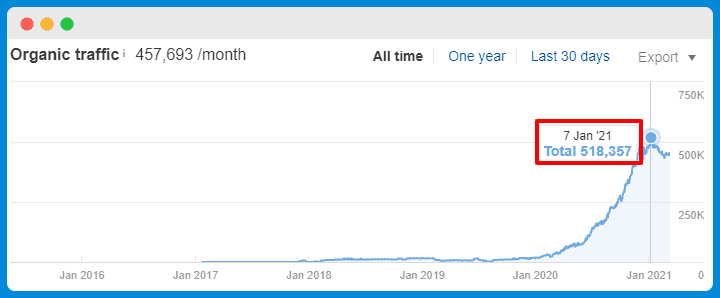
Learn the #1 lever to get the fastest SEO results
Over the last six months, we’ve reviewed 1,000+ writer profiles across dozens of job sites, assigned more than 200 sample work tests, and hired 30 writers.
Key Takeaways
We’ve learned a lot through this journey, and we’re sharing it all with you:
- The economics of hiring in-house writers vs. freelance writers
- Why high-quality writers only cost $.05c per word (note: this does not apply to ROI-driven direct-response marketers like Danial Doan)
- The biggest bottlenecks in turning your content investment into organic search revenue
- Why your content calendar is more significant than you think it is
- Where to consistently find the highest quality, most affordable content writers on the internet
- The problem with hiring from Facebook groups and how to navigate around it
- How to minimize the risk of missing writing deadlines
- The four things you need to do to keep your writers happy
The economics of in-house writers doesn’t add up
We work with companies that have raised millions in funding or are incredibly profitable, with $100,000+ per month marketing budgets that don’t hire in-house writers.
Want to know why?
Check out the going rates to hire a writer in Austin, San Francisco, and Seattle, according to GlassDoor.
San Francisco Writer Salaries
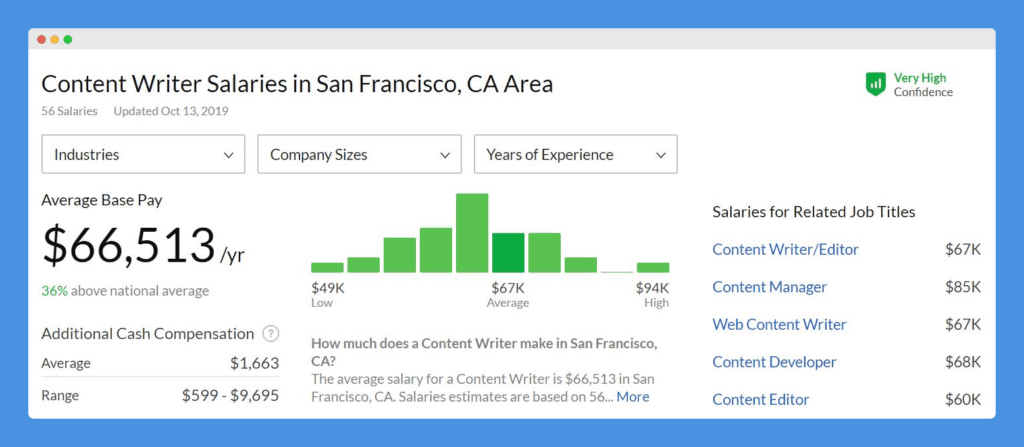
Austin Writer Salaries
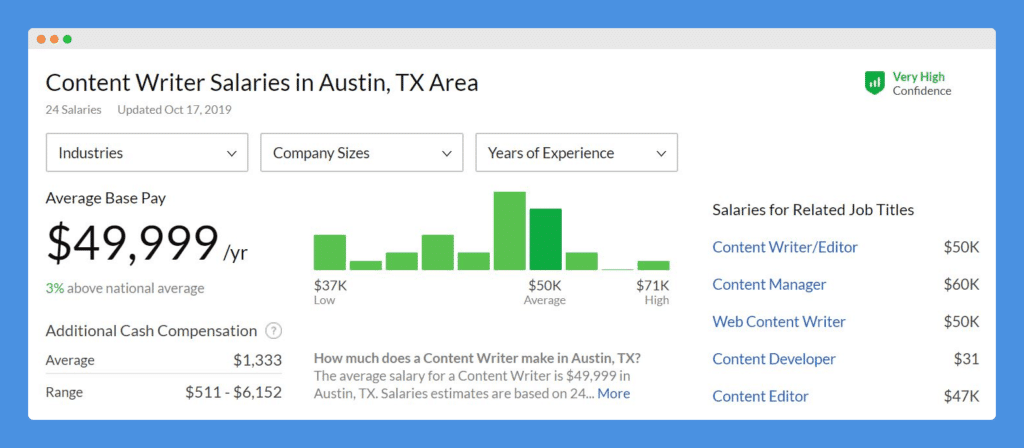
Seattle Writer Salaries
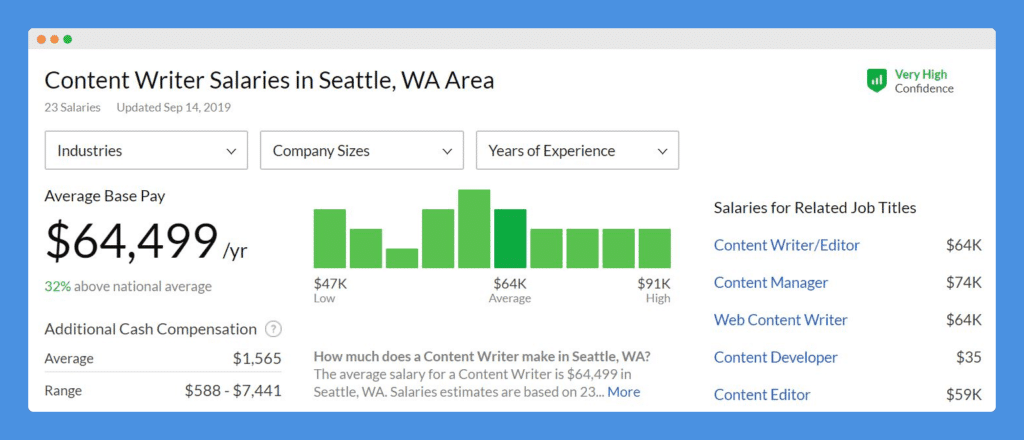
The cost of hiring in-house writers
“The average writer can write 1,000 to 2,000 words per day before their brains begin to fry and quality drops through the floor” – Gordana S., content manager at strongerteams.com.”
That means your in-house content writer is producing somewhere between 20,000 to 40,000 words of content per month. That might sound like a lot. Still, picture an ambitious, B2B brand with the goals of dominating their vertical and appearing everywhere their target audience is searching. It is not uncommon for such a B2B brand to have more than 100 unique content opportunities they need to publish to rank for all of the keywords that could attract qualified traffic.
And it’s not crazy for B2C brands to have thousands of unique content opportunities to get in front of prospects.
That’s a lot of content.
And at 20,000 words per month, and an average of 2,500 words per page, your in-house writer is only producing 6.7 pages of content per month.
Here, we did the math for you.
| City | Per Page Rate | Per Word Rate |
| San Francisco | $820 | $0.32 |
| Seattle | $790 | $0.31 |
| Austin | $620 | $0.24 |
At 2,000 words per day / 40,000 words per month:
| City | Per Page Rate | Per Word Rate |
| San Francisco | $410 | $0.16 |
| Seattle | $395 | $0.16 |
| Austin | $313 | $0.12 |
Hidden costs of hiring writers in-house
The rates above are significantly lower than in reality for two reasons:
- The salaries from GlassDoor didn’t factor in taxes and benefits
- The math assumes your writer is producing content five days a week with no time off
Understand how content costs dramatically impacts ROI using our SEO ROI formula (Google Sheet)
When it comes to organic search, all delays are costly
But the cost isn’t the only hidden impact of hiring an in-house writer.
The other impact is on how long it takes for you to begin to rank, generate traffic, and create an impactful acquisition channel.
You see, the two most significant bottlenecks in achieving ROI on an organic search campaign are:
- You can’t rank for a keyword without a page focused on that keyword. The first bottleneck is how long it takes you to work through and publish your content calendar to execute on all of the opportunities you identified to drive qualified traffic through the buying funnel
- The second bottleneck is how long it takes to start ranking and generating traffic after publishing
If you need to publish 100 pieces of content to rank for all of the keywords that you identified as able to drive qualified traffic, it will take you 15 months to work through your content calendar.
That means that content published in months 7 to 12 is still maturing and providing minimal business impact a year into your organic content distribution campaign.
A 15-month content calendar plus a 6-month maturation time means it will take your content nearly two years to fully mature.
A two-year timeline to turn organic search into a viable acquisition channel might be OK for some brands, but ambitious brands that want to crush search and generate massive audiences don’t have time to wait two years to do it.
Smart, ambitious brands front-load their content calendar.
Instead of publishing 6.7 pieces of content per month for 15 months, they publish their 15-month content calendar in six months.
That’s 17 pieces of content being published every month.
With a 6-month maturation time, that means by month eight, 34 pages are ranking and generating business impact. By month 12, all 100 pieces of content have matured enough to begin to rank, generate traffic, and create business value.
Here is another example of what happens when you front-load content creation.
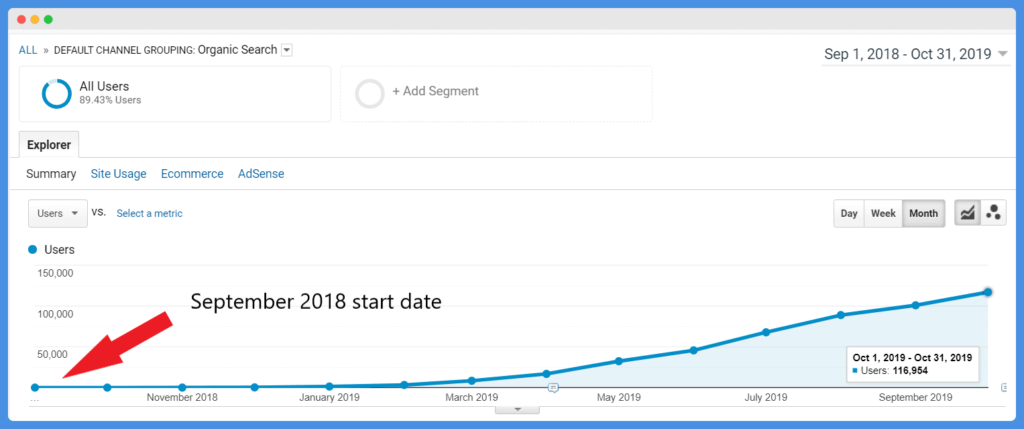
Seriously, learn the #1 lever to get the fastest seo results
Where to hire the highest quality, most affordable freelance writers
+45 Facebook Groups with Highest Quality,
Most Affordable Writers on the Internet.
If you want to rank, you’ll need content. Lots of it. Stop spending tons of cash on writers that can get you no more than 3 articles a month.Enter your name here…Enter your email here…SEND ME THE LIST NOW!
We do not sell or share your information with anyone.
We’ve hired writers from almost every job board out there:
We consistently find the highest quality, most affordable writers in Facebook groups.
Specifically, we find them in Facebook groups for ex-pats, foreigners, and digital nomads in low-cost-of-living countries across Europe, Asia, and Latin America.
When we recruit native English speakers in low-cost-of-living countries, we consistently find high-quality writers at $.05/word.
And we’re able to find high-quality writers at $.05/word, whether we need fashion content, marketing content or anything in between.
The only time we need to spend more to hire high-quality writers is for very technical verticals.
We can even find amazing writers that have written for brands like Microsoft, at $.10/word.
To summarize the cost of hiring in-house vs. freelance writers
We did the math for you again, and it’s not pretty. The table below is based on 100 pieces of content at 2,500 words each.
| Type | Per Word | Total Cost |
| San Francisco | $0.32 | $80,000.00 |
| Seattle | $0.31 | $77,500.00 |
| Austin | $0.24 | $60,000.00 |
| Freelancer in LCOL Country | $0.05 | $12,500.00 |
When you work with freelance writers, you can hire enough to get through your content calendar in 6 months rather than 21 months.
Think 2,500 words is too long for a blog post? Think again.
Writing more words is one of the core philosophies in ranking without backlinks.
Your Content Calendar Is Bigger Than You Think
Ambitious brands don’t just want to rank for a few keywords related to their product.
Ambitious brands want to touch their target audience multiple times across the buying funnel.
Once that qualified visitor lands on their page, they’ll fire a pixel and follow him or her across the internet.
If you are servicing a national or international audience (as opposed to local), chances are high your content calendar is a lot bigger than you think.
Like exponentially bigger.
Here are a couple of examples.
BrandChamp.io
BrandChamp helps e-commerce brands scale their influencer, ambassador, and affiliate campaigns to thousands of participants without the manual overhead of managing a vast program.
Their target audience is marketers working within e-commerce companies.
What does that buyer persona search for?
Influencer and ambassador related content.
If I were BrandChamp, I’d want to be everywhere my target audience was searching.
(To be fair to BrandChamp, they’re outranking bigger brands, with larger budgets and more backlinks for the opportunities we did target, learn how in BrandChamp’s SEO for B2B SaaS case study.
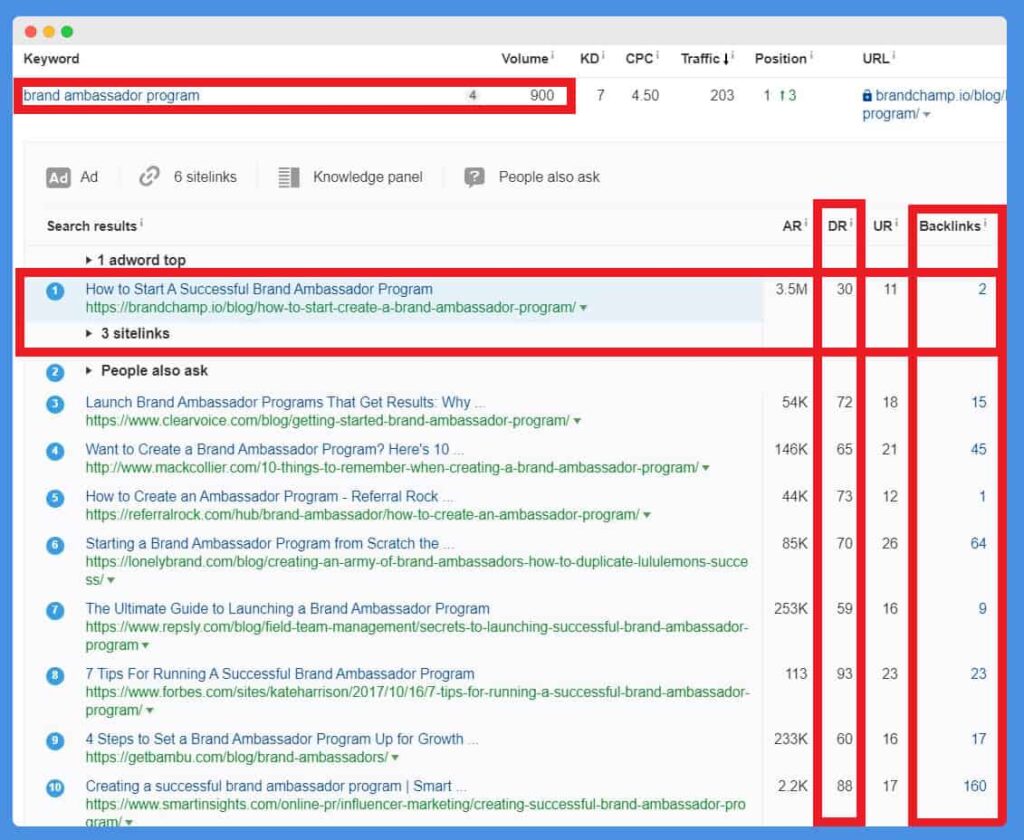
But if they want to own their vertical and become a name brand with their target audience, they need to publish a lot more content.
Let’s check out the keyword groupings:
https://airtable.com/embed/shrr2iX8PlAkjgfaU?backgroundColor=red&viewControls=on
How much more revenue would BrandChamp make if they generated the same amount of organic search of traffic as InfluencerMarketingHub.com?
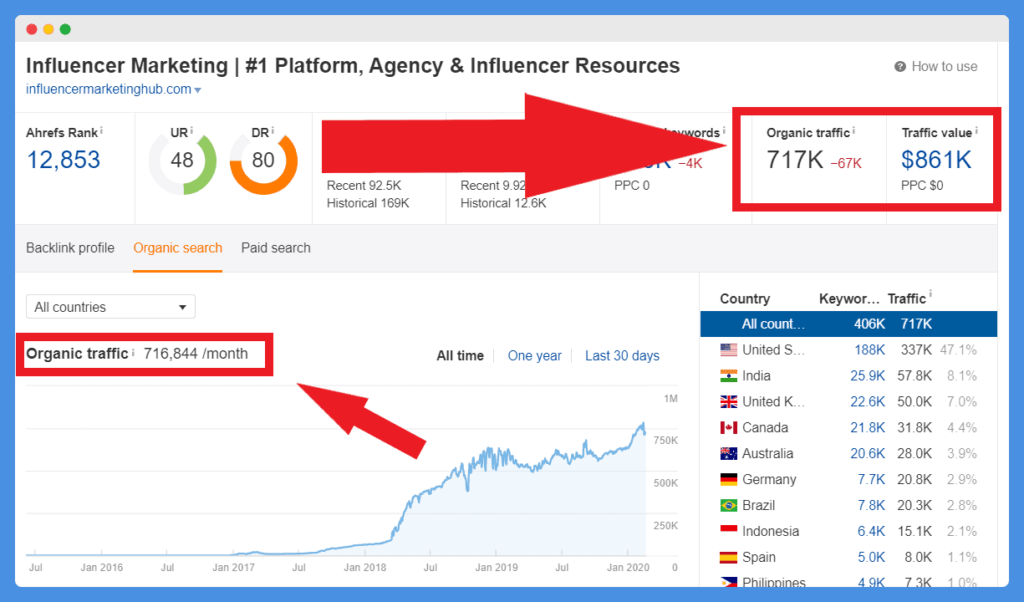
With an estimated 717,000 organic search visitors per month from the exact audience BrandChamp sells to, BrandChamp would likely earn millions more.
But to get there, Influencer Marketing Hub published over 850 pages of high quality content.
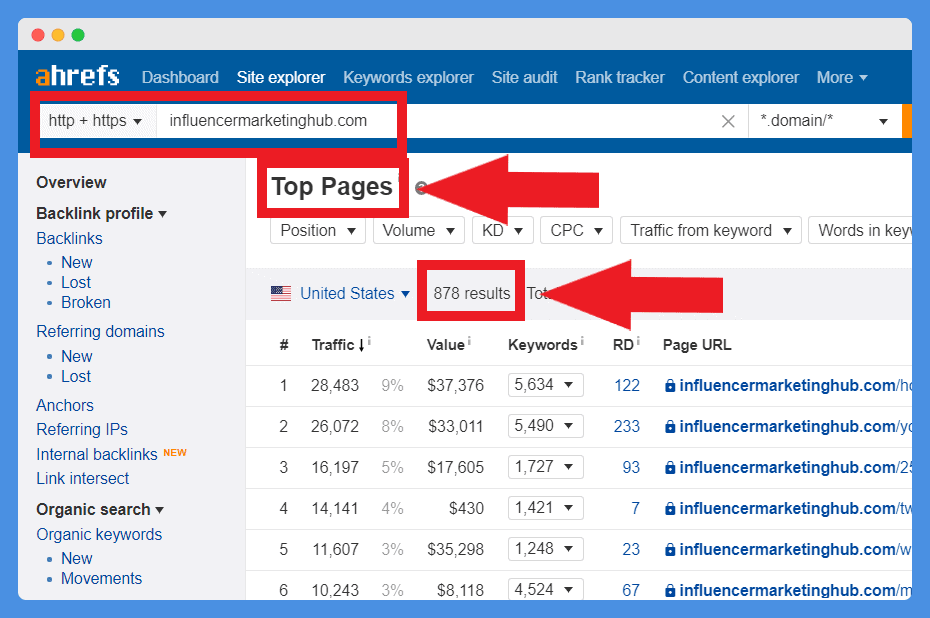
Automate your B2B SaaS keyword research with ClusterAi
Tenzo Tea
Tenzo Tea sells Matcha tea with <3 from California.
Their audience is searching Google for Matcha.
There are 88,000 ways people search Google using the word ‘Matcha.’
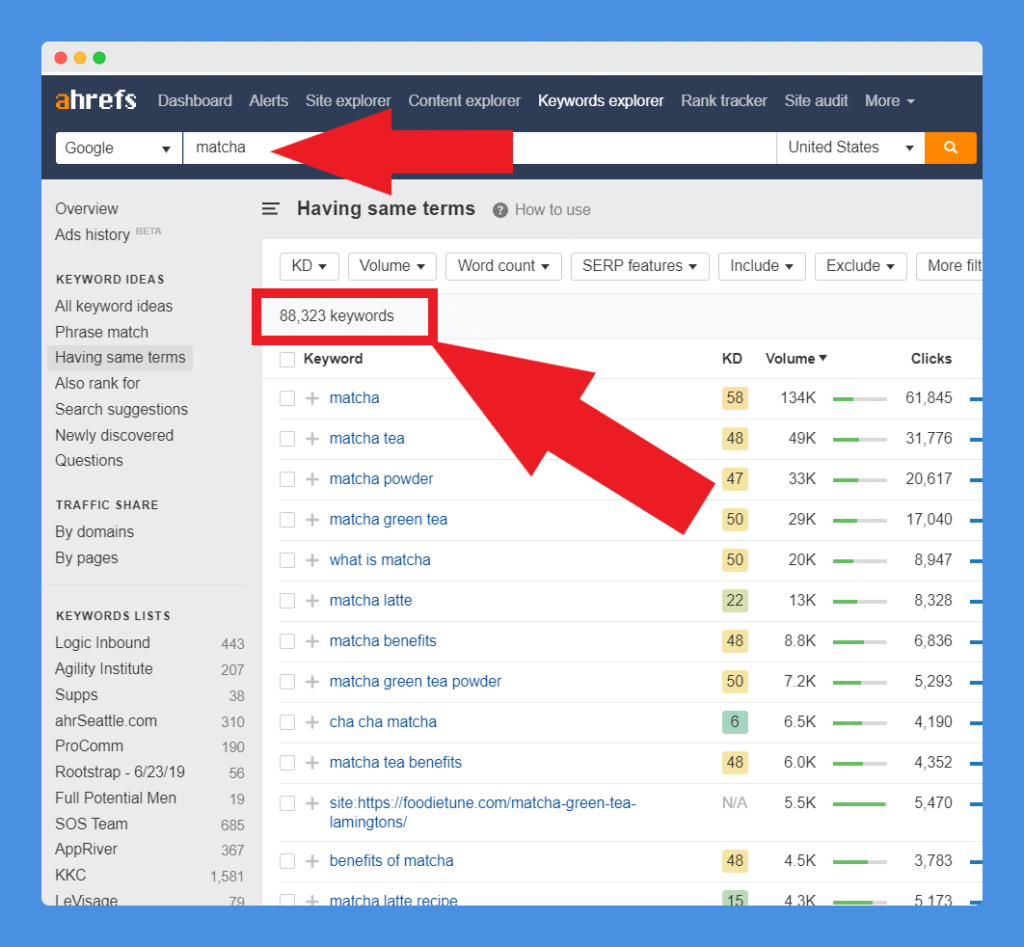
How many unique pages of content does Tenzo Tea need to create to rank for all of the paths their target audience is taking across the buying funnel?
Over 100.
Want to know how we figured that out?
We’ve been using ClusterAi, a keyword grouping tool that does it for us.
It helps us reduce our keyword research time from 30 minutes per page to 30 minutes per project.
By telling us precisely how many pages we need to create to rank for all of the ways a target audience will search.
And by telling us exactly which variations to use on each page.
Here is how it works:
- Export a list of thousands of keywords from Ahrefs
- Import the list into the ClusterAi
- ClusterAi scrapes the first ten search results of each keyword
- And compares the pages ranking across keywords
- Keywords that have enough URLs in common are grouped into unique content topics
- Keywords that don’t have enough URLs in common are grouped into separate topics
Why does this work so well?
Because if two different keywords have enough URLs in common, it means that a single page can rank for both keywords.
But if two keywords don’t have enough URLs in common, it means each search result is unique, and you can’t rank for both keywords with one page, you need two pages.
Here is what Tenzo Tea’s surface area looks like to get in-front of matcha drinkers.
Yes, the Matcha tea keyword grouping has a combined search volume of 339,000 between the main keyword and its variations.
But that’s a super competitive keyword.
And Tenzo Tea might do everything right, and still not rank.
But some of those other keyword groupings are much more attainable.
And the people searching them are just as ready, if not more ready to buy than ‘Matcha.’
Tenzo Tea should absolutely try and rank for Matcha, but while they’re slogging it out, they should also target all of those other opportunities across the funnel.
Not sure the ROI is there to justify the content cost?
Learn how to calculate your campaign expenses and forecast your SEO ROI.
Building your recruitment funnel
So we’ve communicated how big of an opportunity organic content distribution is.
The next part of this guide focuses on
- Finding the highest quality, most affordable writers on the internet
- How to build a recruiting funnel
- Minimizing the risk of missing publishing deadlines
- The things you need to do to retain your talented writers
Here are 15 Facebook Groups for nomads, ex-pats, and native level English speakers in low-cost of countries that you can recruit from:
The biggest problem when recruiting from Facebook Groups & how to avoid it
The biggest problem recruiting from Facebook Groups is how candidates apply.
It’s completely unstructured.
- People are going to comment on your post.
- And slide into your DMs.
- They’re not going to include the information you need to evaluate them.
- It’s also super easy for DMs to get lost, or stuck in your ‘other’ inbox to which DMs from non-friends are relegated.
Managing 100+ writing candidates via Facebook does not work.
Fortunately, there is an easy solution to structuring your application process that will save you 10x the time if you deploy it.
The solution is using Airtable to create a quick, nearly free applicant tracking solution.
Airtable is Google Sheets on steroids.
On the front-end, writers fill out our Airtable form.
This data goes directly into our recruiting view on Airtable.
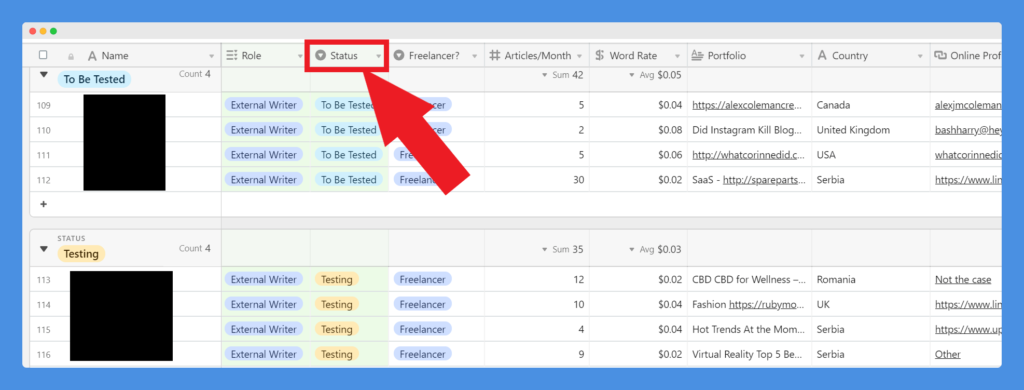
Alright, we have 100+ candidates, and we have everything we need to evaluate them quickly.
When you change the status of a candidate, AirTable automatically sorts them into groups.
The statuses we use are:
| Status | Meaning |
| Candidate | Haven’t reviewed |
| Application Rejected | Didn’t meet hiring criteria, usually due to poor writing skills |
| Too Expensive | Out of project budget |
| Maybe | Decent, but we bet we can find enough better-qualified candidates |
| For Later | Looks good, but lacks the experience for the project we’re hiring for |
| To Be Tested | Looks promising, send them a writing test |
| Testing | We’ve sent the candidate a writing test |
| Test Received | We’ve received their writing test |
| Test Rejected | Writing test didn’t meet quality standards |
| Offer Sent | Sent the candidate the contract details |
| Active | The candidate has accepted the contract |
| Inactive | The writer requested we stop working together, but we’d work with them again |
| Terminated | We fired the writer and won’t work with them again |
Not convinced? Check out StrongerTeams for more reasons why applicant tracking systems are critical in scaling your hiring systems.
Now we start reviewing applications and start assigning statuses:
- Application Rejected
- Too Expensive
- Maybe
- For Later
- To Be Tested
Do a preliminary evaluation of all the candidates. Then, it’s time for batched testing of those candidates with the status To Be Tested.
Each writer we’d like to test receives a templated email:
Email template for testing freelance writers
Hi,
We reviewed your application and would love to invite you to do a test article for us. The article will tell both of us if we’re a good fit and if we should continue our collaboration.
Before we begin, please read through the writing guidelines: [Link]
Also, check out the client details: [Link]
You will find technical requirements in the doc that I’ll share with you in a minute.
We’ll assess the test by:
- Following the technical requirements:
- Proper use of h1 and h2 (with variations provided in the Google Doc)
- The value your content offers to the reader
- Grammar, sentence structure, and punctuation
- How long it takes to edit your work
- How many words we remove during editing (fluff or irrelevant info not wanted)
- Whether it’s delivered on time
- Plagiarism (this is a big one, we have a zero-tolerance policy)
Please paste your work into the doc once you’ve finished.
As far as testing goes, let’s limit it to 1000 words. You can write until you get to 1k even though the article is not done. If this works out, you’ll write the rest. Please note that not all of the technical requirements have to be in the test article. Since it is only 1000 words long, you can have one of each.
The deadline for a test article is DATE and TIME.
If we decide to move forward, I’ll assign a batch of titles for the month. If not, we’ll pay you for the 1000 words the following Friday when all payments are made. We reserve the right to suspend payment to any writer who grossly misrepresented their abilities (i.e., fakes their portfolio or submits a plagiarized article).
Please let me know if you have any questions, and feel free to reach out for help anytime!
Thank you, and good luck!
Email template for freelance writers that pass our writing test
Hi,
I’m pleased to let you know that we’re delighted with your test article and have decided to move forward with your application!
There are a few things to cover before we officially begin:
- The deadline for the work for the week is Wednesday, at 11 pm CEST.
- Once you decide how many articles/words you will write in a week, we expect that you will submit the work by the deadline.
- We assign topics for the month on the 15th of every month.
- All payments are made on Friday. I will email the client and CC you. I’ll provide a breakdown of words written in the previous week and request that you create an invoice that you will then forward to the client for payment.
- Please follow the technical requirements provided in the Writing Guideline. You will find the link to the guideline, as well as the client details in each Google Doc we provide
- We have a zero-tolerance policy for plagiarism. That includes:
- Copying and pasting from another source
- Rewriting an entire article from another source without proper attribution
- Copying and pasting with minor changes
- Every submitted article will go through a plagiarism checker.
- Please confirm the number of articles you can do per week.
If you have decided to move forward, let us know. I’ll assign a new batch of titles, including the test article (which you can finish). Our goal is to make this a long-term collaboration, and if things go well, you can expect to have a steady stream of work from us. Should you ever need help with an article or more guidance, don’t hesitate to contact me. I’m always available and happy to help!
Let me know if you have any questions, and once again, welcome aboard!
Minimizing risk to deadlines
Relying too heavily on too few writers is a recipe for missing deadlines. We’ve learned this lesson the hard way.
These writers are freelancers and will drop you for clients who:
- Pay more
- Request fewer revisions
- Pay on-time
- Are nicer to work with
Points #2 to #4 are absolutely within your control, but #1 may not be, and when we lose writers, it’s always due to #1.
It’s unfortunate to lose a great writer, but if you design your content distribution infrastructure correctly, it won’t impact your deadlines.
The key to minimizing risk to deadlines is hiring enough writers so that each writer is only writing one article per week.
There is nothing worse than assigning a bunch of content to a writer, communicating timelines to other stakeholders, then being blindsided by a resignation email, or getting ghosted when you touch base.
When you assign one article per week to a writer, and they quit or ghost you, you can re-assign that piece of content to another writer, and because you’re working with a handful of writers, the impact on your timeline of one piece of content is minimal.
The four things you need to retain your writers
Retaining your writers is simple:
Pay them on-time. We pay our freelancers twice a month.
Don’t make your emergency their emergency by springing last-minute deadlines on them. You’re not their only client, and they are juggling other deadlines. Give a seven day turnaround time at a minimum.
Provide enough up-front guidance on precisely what you want so that you can keep the number of revisions to one. The more rounds of revisions you request, the less the writer makes per hour. It also has the benefit of reducing your turnaround time from 1st draft to publishing.
Writers are sensitive, your feedback needs to not only be constructive, but it also needs to be tactful.
Our best content
Want to learn how we’ve grown 4 websites from approximately zero to 100,000 visitors per month?
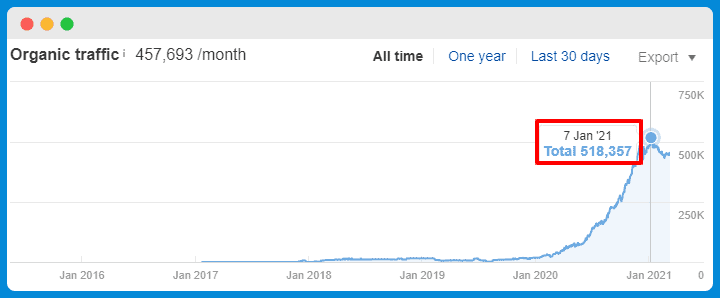
We share it all.
- How to rank without backlinks
- How Google actually works (based on 65,000 page 1 keywords)
- How to turn any writer into an SEO content writer
- The #1 lever to get the fastest SEO results
- How we crush B2C SaaS SEO
- SEO ROI Calculator
- How to find and hire the highest quality, most affordable writers on the internet
- Brand Jacking (ranking for your competitor’s brands)
- How we crush B2B SaaS SEO
